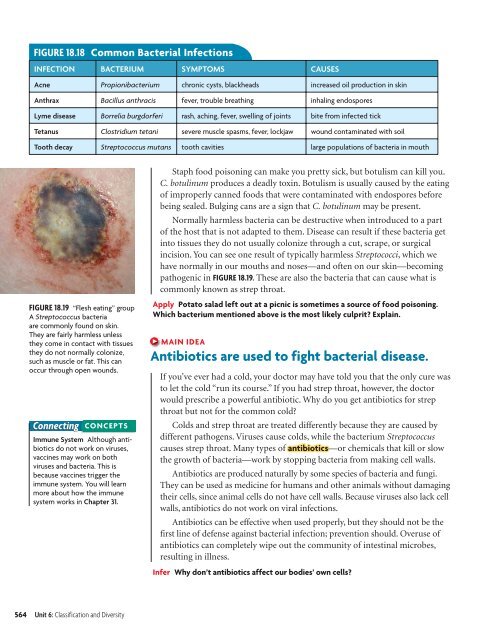18.1 Studying Viruses and Prokaryotes
18.1 Studying Viruses and Prokaryotes
18.1 Studying Viruses and Prokaryotes
Create successful ePaper yourself
Turn your PDF publications into a flip-book with our unique Google optimized e-Paper software.
FIGURE <strong>18.1</strong>8 Common Bacterial InfectionsINFECTION BACTERIUM SYMPTOMS CAUSESAcne Propionibacterium chronic cysts, blackheads increased oil production in skinAnthrax Bacillus anthracis fever, trouble breathing inhaling endosporesLyme disease Borrelia burgdorferi rash, aching, fever, swelling of joints bite from infected tickTetanus Clostridium tetani severe muscle spasms, fever, lockjaw wound contaminated with soilTooth decay Streptococcus mutans tooth cavities large populations of bacteria in mouthFIGURE <strong>18.1</strong>9 “Flesh eating” groupA Streptococcus bacteriaare commonly found on skin.They are fairly harmless unlessthey come in contact with tissuesthey do not normally colonize,such as muscle or fat. This canoccur through open wounds.ConnectingCONCEPTSImmune System Although antibioticsdo not work on viruses,vaccines may work on bothviruses <strong>and</strong> bacteria. This isbecause vaccines trigger theimmune system. You will learnmore about how the immunesystem works in Chapter 31.Staph food poisoning can make you pretty sick, but botulism can kill you.C. botulinum produces a deadly toxin. Botulism is usually caused by the eatingof improperly canned foods that were contaminated with endospores beforebeing sealed. Bulging cans are a sign that C. botulinum may be present.Normally harmless bacteria can be destructive when introduced to a partof the host that is not adapted to them. Disease can result if these bacteria getinto tissues they do not usually colonize through a cut, scrape, or surgicalincision. You can see one result of typically harmless Streptococci, which wehave normally in our mouths <strong>and</strong> noses —<strong>and</strong> often on our skin—becomingpathogenic in FIGURE <strong>18.1</strong>9. These are also the bacteria that can cause what iscommonly known as strep throat.Apply Potato salad left out at a picnic is sometimes a source of food poisoning.Which bacterium mentioned above is the most likely culprit? Explain.MAIN IDEAAntibiotics are used to fight bacterial disease.If you’ve ever had a cold, your doctor may have told you that the only cure wasto let the cold “run its course.” If you had strep throat, however, the doctorwould prescribe a powerful antibiotic. Why do you get antibiotics for strepthroat but not for the common cold?Colds <strong>and</strong> strep throat are treated differently because they are caused bydifferent pathogens. <strong>Viruses</strong> cause colds, while the bacterium Streptococcuscauses strep throat. Many types of antibiotics—or chemicals that kill or slowthe growth of bacteria —work by stopping bacteria from making cell walls.Antibiotics are produced naturally by some species of bacteria <strong>and</strong> fungi.They can be used as medicine for humans <strong>and</strong> other animals without damagingtheir cells, since animal cells do not have cell walls. Because viruses also lack cellwalls, antibiotics do not work on viral infections.Antibiotics can be effective when used properly, but they should not be thefirst line of defense against bacterial infection; prevention should. Overuse ofantibiotics can completely wipe out the community of intestinal microbes,resulting in illness.Infer Why don’t antibiotics affect our bodies’ own cells?564 Unit 6: Classification <strong>and</strong> Diversity
















